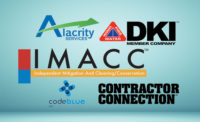Marketing Your Restoration Business through Claims Networks
If you have not embraced restoration networks in your marketing plans, then it’s time for a wake-up call. Firms like Alacrity, Code Blue, Crawford Contractor Connection and IMACC operate networks of restoration firms that will revolutionize how insurance companies interface with their agents, customers and restoration firms.
If you have not embraced restoration networks in your marketing plans, then it’s time for a wake-up call. Firms like Alacrity, Code Blue, Crawford Contractor Connection and IMACC operate networks of restoration firms that will revolutionize how insurance companies interface with their agents, customers and restoration firms. Claims networks offer a superior value proposition to insurance companies compared to the way they handled remediations in the past. Ultimately, networks will take over how most homeowner property damage claims will be handled.
I attended a four-hour presentation on how to market a restoration business at the Connections Show in Clearwater, FL last April. The presenters discussed generating leads for restoration jobs by marketing to the insurance agencies in the contractors trading area. As an insurance agent, I came away thinking, doesn’t everyone already know:
- Insurance companies are trying to streamline claims by taking insurance agents out of the loop on claims.
- Insurance agents really prefer not be in the claims loop because they are not paid by anybody to handle claims.
- In the Internet age, insurance companies cannot afford to have angry customers from a bad remediation project trashing them on Facebook, so there is much greater emphasis today on a consistent customer claims experience.
- Calling on insurance agencies must be an unsustainable marketing play for a restoration firm.
Judging on where the marketing dollars are being spent by restoration firms today, apparently everyone does not know about the forces driving change in the insurance agent/claims interface. The firms that do understand the driving forces of change are likely to come out ahead.
I run an insurance agency. We have hundreds of clients, most of which are restoration firms, and we trade in all 50 states. I also serve as a technical resource to 22,000 insurance agencies through the Independent Insurance Agents of America in Washington D.C. So I know a lot about the restoration business and the insurance agency business. I do not think calling on folks who lose money in the process of referring you restoration work is a long-term marketing play for your business. Technology has permanently changed the game in sourcing your restoration work.
Insurance companies are using technology to create a better claims experience for their customers and to avoid being trashed on the Internet for a remediation project gone bad. The Internet is the great equalizer. Twenty years ago if Betty Lou was angry about a claim, the best she could do, besides report it to the insurance commissioner, was to write a personal complaint in her local newspaper’s gossip section. That same complaint today can be found on Google by a consumer in Boston as soon as it is posted. That puts a huge amount of pressure on insurance companies to make sure everyone is always happy with the restoration services work they get after a loss. The carrier cannot afford a vocal unhappy customer because it impedes the sale of insurance policies over their entire trading area.
It is impossible for an insurance company to deliver consistent claims experiences when they add the variation in the claims process that occurs when an uncompensated insurance agent, with no expertise in restoration work, sets work into motion with one of his fishing buddies. There is nothing wrong inherently with that system. The work is likely perfect and the customer well satisfied. What is becoming intolerable at the insurance companies is that they have no way of avoiding variation in the outcomes of the remediations if they have no control over who does the remediation work.
The solution for the insurance companies is to remove the insurance agent from claims processes and to enter into master service agreements either with franchise organizations or claims services networks. Of the two, by far the fastest growing are the networks.
The networks have a few essential common denominators:
- A computer system that costs a lot of money to develop. The computer systems assign jobs to the network contractors and keep track of the progress on the job.
- A group of qualified and insured contractors to send to the jobs on very short notice.
- Some sort of quality monitoring.
- A satisfaction guarantee of the work performed.
So what’s the main competitive advantage of a claims services network? It’s that once the foundation of one is set, the incremental cost to add in another insurance company to use their network services is a small fraction of the cost the insurance company would incur building their own network of restorers. For this reason alone, I foresee the regional carriers (i.e., the ones still using insurance agents to assign restoration firms to their customers) gravitating to the existing networks in the near future.
What do the industry insiders think? To find out, I went to the heads of the four largest claims networks to get their perspectives on the overall value proposition of a network to an insurance company. Here is what they said:
Jeff Maldonado, Vice President, Alacrity Services: “It’s about taking care of our client’s customer at a time of extreme and urgent need. Short of an assault, nothing is more personal than suffering a loss to a home. We are able to provide customized personal service to the policy holder.”
Larry Thomas, President, Crawford Contractor Connection: “The future is very bright for contractor networks. We continue to see an increasing need for formal contractor programs as the insurance industry embraces the value that can be provided through well-managed contractor programs. Along with the many operational aspects of the Contractor Connection managed repair program, one of the key values in our offering is a consistent level of credentialing that must be met by all service providers. Therefore, we look for established contractor firms that are financially stable with proper levels of insurance that believe in making investments in their business to be a premiere company. This, along with a strong operational performance we require in our network, brings tremendous value to the insurance carrier.”
Pat Harmon, President/CEO, IMMAC: “Our client insurers and property management companies need the whole enchilada: cost reductions, remarkable customer service, comprehensive documentation and increased efficiencies. The emerging business climate suggests we are entering the Age of Transparency and Trust. Consumers expect transparency or they will not give us their trust and business. Trust will become the new marketing juice.”
Paul Gross, President, Code Blue: “We are focused on accuracy and consistency in the claim process and customer experience. The cost and efficiency advantages of networks for insurance companies and their policyholders are self evident. What is not as obvious is the advantage a network gives to an insurance company that wants to expand into new territories. Contractors need to be focused on creating value for their customer, not creating value for the contractor. Networks add value to the customer of the insurance company, (and) for this reason, contractors should be embracing networks as if the network was the customer.”
So what does it take for a restoration firm to get into a network?
The four leading networks all had the same basic answer to this question: They look for experienced firms that do quality work with a proven ability to use communication technology. According to Bill Lang, Manager of Contracts & Credentialing, Alacrity, the No. 1 barrier that restoration firms face in getting into the Alacrity network is getting their insurance programs in line with the insurance specifications.
All of the networks have a good idea where a firm can find insurance that complies with their specifications. In fact, that information on where to go to find compliant insurance is usually supplied by the network in the credentialing materials sent to the contactors.
The insurance specifications are designed specifically to back-stop the commitments the network has made to their insurance company customers. Those commitments will normally be passed down to you in the form of an indemnity obligation. Under your contract with the network, you will need to indemnify the network and maybe the insurance company whether you have insurance to back you up or not.
If you are having trouble with the certificate of insurance to the network, it could be a warning that you are not insured for the things you need to be insured for. By far the easiest way to deal with the complexities of this situation is to give the entire packet of information that you receive from the network to your insurance agent with your instructions to fully explore the insurance options recommended by the network. The networks see hundreds and hundreds of insurance certificates from their network firms and they know which insurance vendors do a good job for them.
There is really no reason that insurance should be the number one barrier to getting into and staying in a network. Good insurance usually, but not always, will cost more than insurance that does not cover what you do for a living. Maybe you do not mind personally being the insurance company of a multi-billion dollar company if you cause a loss on a job without the insurance coverage you need, but the managers of the networks sure do. What may seem to be a lot of hassle on insurance from the network is really designed to prevent you from having design defects in your insurance coverage.
Networks are the wave of the future for sourcing restoration work and there is no turning back the technology that is driving the change and no other business model that will compete with them.
Looking for a reprint of this article?
From high-res PDFs to custom plaques, order your copy today!









